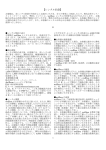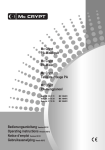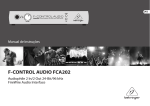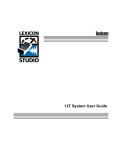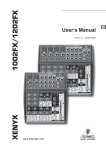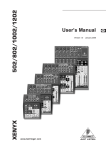Download Pronomic PMX-1804FX Users manual
Transcript
Disposal / WEE declaration Rechargeable Batteries and Batteries The supplied rechargeable batteries or batteries are recyclable. Please dispose of them at special waste collection points or your local dealer. Only dispose of exhausted batteries or rechargeable batteries to ensure environmental protection. Pronomic PMX-1804FX WEEE-Declaration Your product is designed and manufactured with materials and components of high quality, which are recyclable and can be reused. The symbol means that your product should be disposed of separately from household waste when it reaches its end of life. Please dispose of this equipment at your local collection point or recycling center. Please help to protect the environment in which we all live. CE All specifications and appearances are subject to change without notice. All information was correct at time of printing. Musikhaus Kirstein GmbH does not guarantee for the accuracy or completeness of any description, photograph or statement contained in this manual. Printed colors and specifications may vary slightly from product. Products from Musikhaus Kirstein GmbH are only sold through authorized dealer. Distributors and dealers are not agents of Musikhaus Kirstein GmbH and have no authority to bind Musikhaus Kirstein GmbH legally in any way. This manual is protected by copyright. Any copying or reprint, even in excerpts, is only allowed with written consent of Musikhaus Kirstein GmbH. The same applies to reproduction or copying of images, even in altered form. Users manual 00024066 Version 01/2012 IMPORTANT SAFETY SYMBOLS PMX Series Mixer Physical PMX1204FX Dimensions (H x W x D) weight (net) CAUTION RISK OF ELECTRIC SHOCK DO NOT OPEN 251 x 324 x 89 mm 3.5 kg PMX1404FX Dimensions (H x W x D) weight (net) 312 x 324 x 102 mm 5.5 kg PMX1604FX Dimensions (H x W x D) weight (net) 365 x 324 x 102 mm 5.8 kg PMX1804FX Dimensions (H x W x D) weight (net) 418 x 324 x 102 mm 6.4 kg Output Power PMX1204FX PMX1404FX PMX1604FX PMX1804FX 2 x 100W 2 x 300W 2 x 300W 2 x 300W THD+N +A PMX1204FX PMX1404FX PMX1604FX PMX1804FX 0.5% 0.1% 0.1% 0.1% S/N +A PMX1204FX PMX1404FX PMX1604FX PMX1804FX > 80 dB > 80 dB > 80 dB > 80 dB Frequency 20Hz-20KHz (+0, -1dB) The symbol is used to indicate that some hazardous live terminals are involved within this apparatus, even under the normal operating conditions, which may be sufficient to constitute the risk of electric shock or death. The symbol is used in the service documentation to indicate that specific component shall be replaced only by the component specified in that documentation for safety reasons. Protective grounding terminal Alternating current/voltage Hazardous live terminal ON: Denotes the apparatus is turned on OFF: Denotes the apparatus is turned off. WARNING: Describes precautions that should be observed to prevent the danger of injury or death to the operator. CAUTION: Describes precautions that should be observed to prevent danger of the apparatus. IMPORTANT SAFETY INSTRUCTIONS ·Read these instructions. ·Keep these instructions. ·Heed all warning. ·Follow all instructions. Measuring conditions: 1: 1kHz rel.to 0 dBu; 20 Hz - 20 kHz, line input; main output; unity gain. 2: 20Hz - 20kHz; measured at main output. Channels 1 - 4 unity gain: EQ flat; all channels on main mix; channels 1/3 as far left as possible, channels 2/4 as far right as possible. Reference = +6 dBu. ·Water & Moisture The apparatus should be protected from moisture and rain, can not used near water, for example: near bathtub, kitchen sink or a swimming pool, etc. ·Heat 18 The apparatus should be located away from the heat source such as radiators, stoves or other appliances that produce heat. ·Ventilation PMX Series Mixer Do not block areas of ventilation opening. Failure to do could result in fire. Always install accordance with the manufacturer's instructions. ·Object and Liquid Entry Objects do not fall into and liquids are not spilled into the inside of the apparatus for safety. ·Power Cord and Plug Protect the power cord from being walked on or pinched particularly at plugs, convenience receptacles, and the point where they exit from the apparatus. Do not defeat the safety purpose of the polarized or grounding-type plug. A polarized plug has two blades with one wider than the other. A grounding type plug has two blades and a third grounding prong. The wide blade or the third prong is provided for your safety. If the provided plug does not fit into your outlet, refer to electrician for replacement. ·Power Supply The apparatus should be connected to the power supply only of the type as marked on the apparatus or described in the manual. Failure to do could result in damage to the product and possibly the user. Unplug this apparatus during lightning storms or when unused for long periods of time. ·Fuse To prevent the risk of fire and damaging the unit, please use only of the recommended fuse type as described in the manual. Before replacing the fuse, make sure the unit turned off and disconnected from the AC outlet. ·Electrical Connection Improper electrical wiring may invalidate the product warranty. ·Cleaning Clean only with a dry cloth. Do not use any solvents such as benzol or alcohol. ·Servicing Do not implement any servicing other than those means described in the manual. Refer all servicing to qualified service personnel only. ·Only use accessories/attachments or parts recommended by the manufacturer. ·Warning Please remember the high sound pressure do not only temporarily damage your sense of hearing, but can also cause permanent damage. Be careful to select a suitable volume. Aux sends Type Impedance Max.output level 1/4" TS connector, unbalanced approx. 20 kΩ +22 dBu Stereo aux return Type Impedance Max.input level 1/4" TRS connector, electronically balanced approx. 20 kΩ bal. /10 kΩ unbal. +22 dBu Main outputs Type Impedance Max.output level XLR electronically balanced approx. 240Ω bal./ 120Ω unbal. +28 dBu Control room outputs Type Impedance Max.output level 1/4"TS connector, unbal. approx. 120 Ω +22 dBu Headphones output Type Max.output level 1/4" TRS connector, unbalanced +19 dBu / 150Ω(+25 dBu) DSP Converter Sampling rate Main mix system data2 Noise Main mix @ -∞, Channel fader -∞ Main mix @ 0 dB, Channel fader -∞ Main mix @ 0 dB, Channel fader @ 0 dB Power supply PMX1204FX Mains voltage Power consumption Fuse Mains connection PMX1404FX/PMX1604FX/PMX1804FX Mains voltage Power consumption Fuse Mains connection 24-bit Texas Instruments 24-bit Sigma-Delta. 64/128-times oversampling 40 kHz -105 dB / -108 dB A-weighted -95 dB / -97 dB A-weighted -82.5 dB / -85 dB A-weighted 100 -240 V~, 50/60 Hz 200 W 100 -240 V~, T10AH 250V Standard IEC receptacle 100-240 V~, 50/60 Hz 1000 W 100-120V, T10AH 200-240V, T5AH Standard IEC receptacle 17 PMX Series Mixer PMX Series Mixer 5.SPECIFICATIONS Mono inputs Microphone inputs (XENYX Mic Preamp) Type Mic E.I.N. (20 Hz - 20 kHz) @ 0 Ω source resistance @ 50 Ω source resistance @ 150 Ω source resistance Frequency response Gain range Max. Input level Impedance Signal-to noise ratio Distortion (THD+ N) Line input Type 1.INTRODUCTION..........................................................................2 XLR, electronically balanced, discrete input circuit -134 dB / 135.7 dB A-weighted -131 dB / 133.3 dB A-weighted -129 dB / 130.5 dB A-weighted <10 Hz -150 kHz (-1 dB), <10 Hz -200 kHz (-3 dB) +10 to +60 dB +12 dBu @ +10 dB gain approx. 2.6 kΩ balanced 110 dB / 112 dB A-weighted (0 dBu In @ +22 dB gain) 0.005% / 0.004% A-weighted Impedance 1/4" TRS connector, electronically balanced approx. 20Ω banlanced Gain range Max. Input level 10 kΩ unbanlanced -10 to +40 dB 30 dBu Fade-out attenuation1 (Crosstalk attenuation) Main fader closed Channel muted Channel fader closed Frequency response Microphone input to main out <10 Hz - 90 kHz <10 Hz - 160 kHz Stereo inputs Type 90 dB 89.5 dB 89 dB +0 dB / -1 dB +0 dB / -3 dB Impedance Max. Input level 1/4" TRS connector, electronically balanced approx. 20 kΩ +22 dBu EQ mono channels Low Mid High 80 Hz / 15 dB 2.5 kHz / 15 dB 12 kHz / 15 dB EQ stereo channels Low Mid High 80 Hz / 15 dB 2.5 kHz / 15 dB 12 kHz / 15 dB 16 TABLE OF CONTENTS 1.1 General mixing console functions......................................................................3 1.2 The user’s manual...........................................................................................3 1.3 Before you get started...................................................................................... 3 1.3.1 Shipment ................................................................................................ 3 1.3.2 Initial operation....................................................................................... 3 2.CONTROL ELEMENTS AND CONNECTORS ................................ 3 2.1 Mono channels................................................................................................4 2.1.1 Microphone and line input.........................................................................4 2.1.2 Equalizer................................................................................................ 4 2.1.3 Aux sends............................................................................................... 5 2.1.4 Routing switch, sole and channel fader...................................................... 5 2.2 Stereo channels.............................................................................................. 6 2.2.1 Channel inputs....................................................................................... .6 2.2.2 Equalizer stereo channels........................................................................ 6 2.2.3 Aux sends stereo channels....................................................................... 6 2.2.4 Routing switch, sole and channel fader...................................................... 6 2.3 Connector panel and main section.....................................................................7 2.3.1 Aux sends 1 and 2....................................................................................7 2.3.2 Aux send connectors 1 and 2.....................................................................7 2.3.3 Stereo aux return connectors....................................................................8 2.3.4 Stereo aux return.................................................................................... .8 2.3.5 Tape input / tape output............................................................................9 2.3.6 Level metre and monitoring...................................................................... 9 2.3.7 Alt 3-4 and main mix fader....................................................................... 11 2.4 Rear view of PMX1204FX/1404FX/1604FX/1804FX..........................................12 2.4.1 Main mix outputs, Alt 3-4 outputs and room outputs................................... 12 2.4.2 Voltage supply, phantom power and fuse.................................................. 12 2.4.3 AMP output............................................................................................ 13 2.4.4 Heat removal system.............................................................................. 13 3.DIGITAL EFFECTS PROCESSOR................................................13 4.INSTALLTION.............................................................................14 4.1 Rack mounting............................................................................................ . 1 4 4.2 Cable connections........................................................................................ 14 4.2.1 Audio connections................................................................................14 5.SPECIFICATIONS.......................................................................16 1 PMX Series Mixer 1.INTRODUCTION Congratulations! In purchasing the MX you have acquired a mixer whose small size belies its incredible versatility and audio performance. The MX Series represents a milestone in the development of mixing console technology. With the new microphone preamps including phantom power as an option. Balanced line input and a powerful effects section. The mixing consoles in the MX Series are optimally equipped for live and studio applications. Owing to state-of-the-art circuitry your MX console produces a warm analog sound that is unrivalled. With the addition of the latest digital technology these base-in-class consoles combine the advantages of both analog and digital technology. The microphone channels feature high-end Mic Preamps that compare well with costly outboard preamps in terms of sound quality and dynamics and boast the following features. PMX Series Mixer Balanced use with XLR connectors 1=groud / shield 2=hot (+ve) 3=cold (-ve) 1 2 3 1 2 3 Output Input For unbalanced use pin 1 and pin 3 have to be bridged Fig. 4.2: XLR connections Unbalanced use of 1/4"TRS connector strain relief clamp * 130dB dynamic range for an incredible amount of headroom sleeve * A bandwidth ranging from below 10Hz to over 200kHz for crystal-clear reproduction of over the finest nuances. * The extremely low-niose and distortion-free circuitry guarantees absolution natural and transparent signal reproduction. sleeve tip ground shield signal tip * They are perfectly matched to every conceivable microphone with up to 60 dB gain and +48 volt phantom power supply. The foot switch connects the two poles momentarily * They enable you to use the greatly extended dynamic range of your. 24-bit/192kHz HD recorder to the full. Thereby maintaining optimal audio quality. “Bitish EQ” The equalizers used for the MX Series are based on the legendary circuitry of top-notch consoles made in Britain, which are renowned throughout the world for their incredibly warm and musical sound character. Even with extreme gain settings these equalizers ensure outstanding audio quality. Mutil-effects processor Additionally, your PMX Series mixing consoles has an effects processor with 24-bit A/D and D/A converters included, which gives you 100 presets producing first-class reverb, delay and modulation effects plus numerous multi-effects in excellent audio quality. The PMX Series mixing consoles are equipped with a state-of-the-art switched-mode power supply (SMPS). Unlike conventional circuitry an SMPS provides an optimum supply current regardless of the input voltage. And thanks to its considerably higher efficiency a switched-mode power supply uses less energy than conventional power supplies. USB/Audio interface The USB interface supplied with the unit is a perfect match for the PMX Series and serves as a powerful recording interface to you PC or MAC. It supports the digital transmission of signals on up to four channel with max 48kHz and extremely low latency. When wired to the CD/TAPE INPUT and OUTPUT connectors,the interface transfers the stereo mix from the console directly to a computer. Both the recording signals and the playback signal from the computer can be monitored at the same time. In this way, you can use several recording runs to produce complete multi-track recordings. We should like to draw your attention to the fact that extreme volumes may damage your hearing and/or your headphones or loudspeakers. Turn the MAIN MIX faders and phones control in the main section fully down before you switch on the unit. Always be careful to set the appropriate volume. 2 Fig. 4.3: 1/4"TS connector Balanced use of 1/4"TRS connector strain relief clamp tip sleeve hot (+ ve) ground shield sleeve ring ring cold (- ve) tip For connection of balanced and unbalanced plus, rig and sleeve have to be bridged at the stereo plug Fig. 4.4: 1/4"TRS connector Headphones connection with 1/4"TRS connector strain relief clamp tip sleeve left signal ground shield sleeve ring ring tip right signal Fig. 4.5: 1/4"TRS connector for headphones 15 PMX Series Mixer PMX Series Mixer This also goes for mixing effects signals with the monitor mix. The main difference is that the mix radio is adjusted using the FX TO MON control. Of course, a signal has to be fed into the effects processor via the FX control in the channel strip for both applications. On the following page, you will find an illustration showing how to connect your foot switch correctly. LEVEL The LED level mater on the effects module should display a sufficiently high level. Take care to ensure that the clip LED only lights up at peak levels. If it is lit constantly, you are overloading the effects processor and this could cause unpleasant distortion. The FX control (AUX SEND 2) determines the level that reaches the effects module. PROGRAM You can select the effect preset by turning the PROGRAM control. The display flashes the number of the current preset. To recall the selected preset, press the button; the flashing stops. You can also recall the selected preset with the foot switch. 4.INSTALLATION 4.1 Rack mounting The packing of your mixing console contains two 19 " rack mount wings which can be installed on the side panels of the console. Before you can attach the rack mount wings to the mixing console, you need to remove the screws holding the left and right side panels. Use these screws to fasten the two wings onto the console, being careful to note that each wing fits a specific side. With the rack mount wing installed. You can mount the mixing console in a commercially available 19" rack. Be sure to allow for proper air flow around the unit, and do not place the mixing console close to radiators or power amps. So as to avoid overheating. Only use the screws holding the mixing console side panels to fasten the 19" rack mounts. 4.2 Cable connections You will need a larger number of cable for the various connections to and from the console. The illustrations below show. The wing of these cables. Be sure to use only high-grade cable. 4.2.1 Audio connections Please use commercial RCA cables to wire the 2-track inputs and outputs. You can, of course, also connect unbalanced devices to the balanced input/outputs. Use either mono plugs, or ensure that ring and sleeve are bridged inside the stereo plug (or pins 1 & 3 in the case of XLR connectors). Caution! You must never use unbalanced XLR connectors (pin 1 and 3 connected) on the MIC inputs if you in tend to use the phantom power supply. 1/4" TS connector for use with foot switch strain relief clamp sleeve sleeve tip pole 1/ground pole 2 14 A mixing console fulfils three main functions: *Signal processing: Preamplification, level adjustment, mixing of effects. Frequency equalization. *Signal distribution: Summing of signals to the aux sends for effects processing and monitor mix, distribution to one or several recording tracks, power amp(s), control room and 2-track outputs. *Mix: Setting the volume level, frequency distribution and positioning of the individual signals in the stereo field, level control of the total mix to match the recording devices/crossover/power amplifier(s). All other mixer functions can be included in this main function. The interface of LONGERDB mixing consoles is optimized for these tasks enabling you to easily keep track of the signal path. 1.2 The user’ s manual The user’s manual is designed to give you both an overview of the controls, as well as detailed information on how to use them. In order to help you understand the links between the controls, we have arranged them in groups according to their function. 1.3 Before you get started 1.3.1 Shipment Your mixing console was carefully packed in the factory to guarantee safe transport. Nevertheless, we recommend that you careful examine the packing and its contents for any signs of physical damage. Which may have occurred during transit. If the unit is damaged, please do NOT return it to us, but notify your dealer and the shipping company immediately, otherwise claims for damage or replacement may not be granted. 1.3.2 Initial operation Be sure that there is enough space around the unit for cooling purposes and to avoid over-heating please do not place your mixing console on high-temperature devices such as radiators or power amps. The console is connected to the mains via the supplied cable. The console meets the required safety standards. Blown fuses must only be replaced by fuses of the same type and rating. Please note that all unit must be properly grounded. For your own safety, you should never remove any ground connectors from electrical devices or power cables, or render them inoperative. Please sure that only qualified people install and operate the mixing console. During installation and operation, the user must have sufficient electrical contact to earth, otherwise electrostatic discharges might affect the operation of the unit. 2.CONTROL ELEMENTS AND CONNECTORS tip The foot switch connects the two poles momentarily 1.1 general mixing console functions Fig. 4.1: 1/4" TS connector for foot switch This chapter describes the various control elements of your mixing console. All controls, switches and connectors will be discussed in detail. 3 PMX Series Mixer PMX Series Mixer SPEAK OUTPUTS Min load 4Ω 2.1 Mono channels L 2.4.3 AMP Output 2.1.1 Microphone and line inputs +1 MIC -1 R Each mono input channel offers a balanced microphone input via the XLR connector and also features switchable +48V phantom power supply for condenser microphones. The PMX preamps provide undistorted and noised-free gain as is typically known only from costly outboard preamps. MIC LINE IN LOW CUT 75Hz 18 dB/Oct +10 +10 -40 +60 TRIM 1 dB/dBu Fig. 2.1: Connectors and controls of mic/line inputs +2 LINEIN Each mono input also features a balanced line input on a 1/4" connector. Unbalanced devices (mono jacks) can also be connected to these inputs. please remember that you can only use either the microphone or the line input of a channel at any one time. You can never use both simultaneously! LOW CUT The mono channels of the mixing consoles have a highslope LOW CUT filter for eliminating unwanted, low-frequenty signal components (75 Hz, 18 dB/octave). TRIM Use the TRIM control to adjust the input gain. This control should always be turned fully counterclockwise whenever you connect or disconnect a signal source to one of the inputs. Fig. 2.16: AMP output 2.4.4 Heat removal system DO NOT OBSTRUCT AIR VENTS HEAT REMOVAL SYSTEM This is the mixer's stereo amp fan refrigeration system. It works with low speed in normal temperature (≤45℃). When it is higher than 45℃, it will quicken up. Fig. 2.17: Heat removal system Caution! You must never use unbalanced XLR connectors (PIN 1and 3 connected) on the MIC input connectors if you want to use the phantom power supply. SERIAL NUMBER Please note the important information on the serial number given in chapter 1.3.3. 2 4 - BIT MULTI - FX PROCESSOR FX FOOTSW EQ 0 PHONES HIGH 00 03 06 09 10 13 16 19 20 27 30 SMALL HALL MID HALL BIG HALL CHURCH SMALL ROOM MID ROOM BIG ROOM CHAPEL PLATE SPRING GATED REV 36 40 44 48 49 50 59 60 66 70 74 REVERSE EARLY REFL AMBIENCE STADIUM AMBIENCE FX DELAY ECHO CHORUS FLANGER PHASER PITCH SHIFT 80 82 84 86 88 90 91 92 94 96 98 CHORUS & REVERB FLANGER & REVERB PHASER & REVERB PITCH & REVERB DELAY & REVERB DELAY & GATED DELAY & REVERSE DELAY & CHORUS DELAY & FLANGER DELAY & PHASER DELAY & PITCH 12 KHz -15 0 +15 MID 2.5 KHz -15 0 +15 LOW 80 Hz -15 24-BIT DUAL ENGINE DSP CLIP -3 3.DIGITAL EFFECTS PROCESSOR 24-BIT MULTI-EFFECTS PROCESSOR Here you can find a list of all presets stored in the multieffects processor. This built-in effects module produces high-grade standard effects such as reverb, chorus, flanger, delay and various combination effects. The integrated effects module has the advantage of requiring no wiring. This way, the danger of creating ground loops or uneven signal level is eliminated at the outset, completely simplifying the handing. -6 -10 -15 -20 LEVEL 24-BIT A/D & D/A CONVERTER PROGRAM (PUSH) +15 Fig. 2.2: Panorama and routing controls 4 The upper (HI) and the lower band (LO) are shelving filters that increase or decrease all frequencies above or below their cut-off frequency. The cut-off frequencies of the upper and lower band are 12 kHz and 80 Hz respectively. The mid band is configured as a peak filter with a centre frequency of 2.5kHz Note: Keep the windhole free, or the equipment will be too hot and turn to protection in advance. After the phantom power supply has been switched on, do not connect microphones to the mixer (or the stagebox/wallbox). Connect the on. In addition, the monitor/PA loudspeakers should be muted before activating the phantom power supply. After switching on, wait approx. One minute to allow the system to Stabilize. 2.1.2 Equalizer All mono input channels include a 3-band equalizer. All bands provide boost or cut of up to 15dB. In the central position, the equalizer is inactive. The circuitry of the British EQs is based on the technology used in the bast-known top-of-the-line consoles and providing a warm sound without any unwanted side effects. The result are extremely musical equalizes which, unlike simple equalizers, cause no side effects such as phase shifting or bandwidth limitation, even with extreme gain settings of ±15 dB. AMP OUTPUT This speakon socket is for stereo Amp L/R output. It's used to connect speaker cabinet by speakon NL 4FC. Note: Min Load 4Ω Please mute your play back system before you active the phantom power supply to prevent switchon thump being directed to your loudspeakers. Please also note the instructions in chapter 2.4.2 “Voltage supply, phantom power and fuse”. BAL OR UNBAL -2 These effect presets are designed to be added to dry signals. If you move the FX TO MAIN control, you mix the channel signal (dry) and the effect signal. Fig. 3.1: Digital effects module 13 PMX Series Mixer PMX Series Mixer 2.4 Rear view of PMX1204FX/PMX1404FX/PMX1604FX/PMX1804FX 1 AUX 0 2.4.1 main mix outputs, Alt 3-4 outputs and control room outputs ALT 3-4 OUTPUTS MAIN OUTPUTS R L ALT 3-4 OUTPUTS L 4 3 CONTROL ROOM OUT R L - +15 8 MAIN OUTPUTS PIN 2 = HOT / PIN 3 = COLD R POST PRE 4 0 2 2.1.3 Aux sends Aux sends take signals via a control from one or more channels and sum these signals to a so-called bus. This bus signal is sent to an aux send connector and then routed, for example, to an active monitor speaker or an external effects device. The return from an external effect device can then be brought back into the console via the aux return connectors. PIN 2 = HOT / PIN 3 = COLD FX PMX1404FX/ PMX1604FX/ PMX1804FX CONTROL ROOM OUT PMX1204FX Fig. 2.14 Main mix outputs, Alt 3-4 outputs and control room outputs MAIN OUTPUTS The MAIN outputs carry the MAIN MIX signal and are on balanced XLR connectors with a nominal level of +4dBu. ALT 3-4 OUTPUTS The ALT 3-4 output are unbalanced and carry the signals of the channels that you have assigned to this group using the MUTE switch. This can be used to route a subgroup to a further mixing console for example, or it could be used as a recording output working in tandem with the main output. This means you could record to four tracks simultaneously. The icing on the cake, so to speak, is that you could connect Y-cables to these four outputs and then connect your 8-track recorder in such a way that you have 2 x 4 tracks. (E.g. Channel 1 feeds track 1and track 2, etc.). In the first recording pass, you record on track 1, 3.5 and 7 and in the second pass, on tracks 2, 4, 6 and 8. CONTROL ROOM OUTPUT The control room output is normally connected to the monitor system in the control room and provides the stereo mix or, when required, the solo signal. - +15 8 L R 3 Fig. 2.3: The AUX SEND controls in the channel strips For situations which require effects processing, the aux sends are usually switched post-fader so that the effects volume in a channel corresponds to the position of the channel fader. if this were not the channel would remain audible even when the fader is turned to zero. When setting up a monitor mix, the aux sends are generally switched to pre-fader, i.e. they operate independently of the position of the channel fader. Both aux sends are mono, are sourced after the equalizer and offer up to +15dB gain. If you press the MUTE/ALT 3-4 switch, aux send 1 is muted, provided that it is switched postfader. However, this does not affect the aux send 2 AUX 1 (MON) Aux send 1 can be switched pre-fader and is thus particularly suitable for setting up monitor mixes. PRE When the PRE switch is pressed, aux send 1 is sourced pre-fader. Aux 2 (FX) The aux send labeled FX is for sending to effects devices and is thus set up to be post-fader. If you wish to use the internal effects processor, the STEREO AUX RETURN 2 connectors should not be is use. You can also connect an external effects processor to aux send 2, however the internal effects module will be muted. 2.4.2 Voltage supply, phantom power and fuse AC 100-120V ~ 60Hz T10AH AC 200-240V ~ 50HZ T5AH POWER ON ON PHANTOM Fig. 2.15: Voltage supply and fuse PAN FUSE HOLDER The console is connect to the mains via the cable supplied which meets the required safety standards. blown fuses must only be replaced by fuses of the same type and rating. IEC MAINS RECEPTACLE The mains connection is via a cable with IEC mains connector. An appropriate mains cable is supplied with equipment. L 2.1.4 Routing switch, solo and channel fader R 1 MUTE ALT 3-4 dB MUTE 10 CLIP 0 SOLO 10 MUTE/ALT 3-4 You can use the MUTE/ALT 3-4 switch to driver the channel from the main mix bus to the Alt 3-4 bus. This mutes the channel from the main mix. 15 POWER Use the POWER switch to power up the mixing the console. 20 25 30 12 40 60 8 PHANTOM The PHANTOM switch activates the phantom power supply for the XLR connectors of the mono channels which is required to operate condenser microphones. The red +48 VLED lights up when phantom power is on. As a rule, dynamic microphones can still be used with phantom power switched on, provided that they are wired in a balanced configuration. In case of doubt, contact the microphone manufacturer! PAN The PAN control determines the position of the channel signal within the stereo image. This control features a constant-power characteristic, which means the signal is always maintained at a constant level, irrespective o position in the stereo panorama. 1 Fig. 2.4: Panorama and routing controls MUTE-LED The MUTE LED indicates that the relevant channel is diverted to the submix (Alt 3-4 bus). 5 PMX Series Mixer PMX Series Mixer CLIP-LED The CLIP LED lights up when the input signal is driver too high. In this case, turn down the TRIM control and, if necessary, check the setting of the channel EQ. SOLO The SOLO switch is used to route the channel signal to the solo bus (Solo In Place) or to the PFL bus (Pre Fader Listen). This enables you to monitor a channel signal without affecting the main output signal. The signal you hear is sourced either before (PFL, mono) or after (solo, stereo) both the pan control and the channel fader (see chapter 2.3.6 “Level meters and monitoring”). The channel fader determines the level of the channel signal in the main mix (or submix). MONO 2.2 Stereo channels L 2.2.1 Channel inputs Each stereo channel has two balanced line level input on 1/4" connectors for left and right channels. If only the connector marked “L” is used, the channel operates in mono. Stereo channels are designed to handle typical line level signals. BAL OR UNBAL R The PAN control in the channel strip offers a constant power characteristic. This means that the signal is always at a constant level, irrespective of its position in the stereo panorama. If the PAN control is moved fully left or right from center, the level increases by 4 dB in that channel. This signal is not louder. For this reason, with the solo function activated (Solo In Place), audio signals from the channels with PAN controls that have not be moved fully to the left or right are displayed at a lower volume that in the PFL function. Also a rule, solo signals are monitored via the control room output and headphones connector and are displayed by the level meters. If a also switch is pressed, the signals from the tape input, Alt 3-4 and main mix are blocked from the control room outputs, the headphone connector and the level meter. MAIN SOLO The MAIN SOLO LED lights up as soon as a channel or aux send solo switch is pressed. The MODE switch also has to be set at “solo”. PFL The PFL LED indicates that the peak metre is set to PFL mode. Both input can also be used with unbalanced jacks. Fig. 2.5: Stereo channel inputs and LEVEL switch LEVEL For level matching, the stereo inputs feature a LEVEL switch which selects between +4 dBu and -10 dBV. At -10dBV (homerecording level), the input is more sensitive than at +4 dBu (studio level). 2.2.2 Equalizer stereo channels The equalizer of the stereo channel is, of course, stereo. The filter characteristics and crossover frequencies are the same as those of the mono channels. A stereo equalizer is always preferable to mono equalizers if frequency correction of a stereo signal is needed. There is often a discrepancy between the settings of the left and the right channels when using separate equalizers. PHONES Fig. 2.12: PHONES connector PHONES You can connect headphone to this 1/4" TRS connector. The signal on the PHONES connection is sourced from the control room output. 2.3.7 Alt 3-4 and main mix fader 3 4 L R 10 10 10 10 0 0 0 0 10 10 10 10 15 15 15 15 20 20 20 20 25 25 25 25 30 30 30 30 40 60 40 60 40 60 40 60 8 LINE IN 7/8 8 LEVEL +4 -10 2.2.4 routing switch, solo and channel fader BAL The function of the BAL(ANCE) control corresponds to the PAN control in the mono channels. The balance control determines the relative proportion between the left and right input signals before both signals are routed to the main stereo mix bus. The MUTE/ALT 3-4 switch, the MUTE-LED, the CLP-LED, the SOLO switch and the channel fader function in the same way as the mono channels. 6 8 In principle, the aux sends of the stereo channels function in just the same way as those of the mono channels. As aux send paths are always mono, the signal on a stereo channel is first summed to mono before it reaches it reaches the aux bus. 8 2.2.3 Aux sends stereo channels ALT 3-4 MAIN MIX Fig. 2.13: Alt 3-4 and main mix fader Use the high-precision quality faders to control the output level of the Alt 3-4 subgroup and main mix. 11 PMX Series Mixer MAIN MIX The MAIN MIX switch sends the main mix signal to the above-mentioned outputs and to the level metre. PHONES/CTRL (ROOM) Use this control to set control room output level and headphone volume respectively. 2-TRACK TO MAIN When the 2-TRACK TO MAIN switch is depressed, the 2-track input is routed to the main thus serves as an additional input for tape machines. You can also connect MIDI further processing. At the same time, this switch disables the main mix to tape output link. PMX Series Mixer 2.3 Connector panel and main section Whereas it was useful to trace the signal flow from top to bottom it order to gain an understanding of the channel strips, we now look at the mixing console from left to right. The signals are, so to speaker, collected from the same point on each of the channel strips and then routed to the main section all together. AUX SENDS 2.3.1 Aux sends 1 and 2 0 1 A channel signal is routed to aux send bus 1 if the Aux 1 control is turned up on the corresponding channel. POWER The blue POWER LED indicates that the device is switched on. 8 Please do not connect microphones to the mixer (or the stagebox/wellbox) while the phantom power supply is switched on. Connect microphones before you switch on the power supply. In addition, the monitor/PA loudspeakers, should be muted before you activate the phantom power supply. After switching on, wait approx. One minute to allow for system stabilization. LEVEL METER The high-procision level meter accurately displays the appropriate signal level. LEVEL SETTING When recording to a digital device, the recorder ’s peak metre should mot exceed 0 dB. This is because, unlike analog recordings, slightly excessive levels can create unpleasant digital distortion. SOLO 15 0 2 8 +48V The red “+48V” LED lights when the phantom power supply is switch on. The phantom power supply is necessary for condenser microphones and is activated using the switch on the rear of the device. AUX SEND 1 (MON) The AUX SEND control MON acts as master control for auxsend 1 and determines the level of the summed signal. FX SOLO 15 Fig. 2.6: AUX SEND controls of the main section AUX SEND 2 (FX) Similarly, the FX control (AUX SEND 2) determines the level for aux send 2. SOLO You can use the SOLO switch to separately monitor the aux sends via the CONTROL ROOM/PHONES outputs and check these with the level metres. If you want to monitor the signal the of just one AUX bus, none of the other SOLO SWITCHES should be pressed and the MODE switch must be in the SOLO position (not pressed down). When recording to an analog device, the VU meters of the recording machine should reach approx. +3 dB with low-frequency signals (e.g. Kick drum). Due to their inertia VU meters tend to display too low a signals level at frequencies above 1 kHz. This is why ,for example, a Hi-Hat should only be driven as far as -10dB. Snare drums should be driven to approx. 0 dB. The peak metres of your XENYX display the level virtually independent of frequency. A recording level of 0dB is recommended for all signal types. MODE The MODE switch determines whether the channels’ SOLO switch operates as PFL (Pre Fader Listen) or as solo (Solo In Place). PFL To activate the PFL function, depress the MODE switch. The PFL function should, as a rule, be used for gain setting purposes. The signal is sourced pre-fader and assigned to the mono PFL bus. In the “PFL” setting, only the left side of the peak meter operates. Drive the individual channels to the 0 dB mark of the VU meter. SOLO When the MODE switch is not depressed, the stereo solo bus is activate. Solo is short for “Solo In Place”. This is the customary method for listening to an individual signal or to a group of signals.As soon as a solo switch is pressed, all channels in the control room (and headphones) that have not been selected are muted thereby retaining stereo panning. The solo bus can carry the output signals of the channel pan controls, the aux sends and the stereo line inputs.The solo bus is, as a rule, switched postfader. 10 1 FX 2 AUX SENDS 2.3.2 Aux send connectors 1 and 2 AUX SEND 1 If you use aux send 1 pre-fader, you would usually connect the AUX SEND 1connector to monitors via a power amp (or an active monitor system). If you use aux send 1 post-fader, proceed as described under aux send 2. Fig. 2.7: Aux send connectors AUX SEND 2 The AUX SEND 2 connector outputs the signal you picked up from the individual channels using the FX control. You can connect this to the input of an effects mix is created, the processed signal can then be routed from the effects device output back into the STEREO AUX RETURN connectors. 7 PMX Series Mixer LEFT /MONO PMX Series Mixer You can now use the STEREO AUX RETURN MON control to adjust the level of the effects signal routed to the monitor mix. RIGHT 2.3.3 Stereo aux return connectors 1 STEREO AUX RETURN 1 2 STEREO AUX RETURNS Fig. 2.8: Stereo aux return connectors The STEREO AUX RETURN 1 connectors generally serve as the return path for the effects mix generated using the postfader aux send. This is where you connect the output signal of the external effects device. If only the connector is used, the AUX RETURN automatically operates in mono. STEREO AUX RETURN 2 (FX) The STEREO AUX RETURN 2 control determines the level of signals fed into the AUX RETURN 2 connectors which are routed to the main mix. MAIN MIX/ALT 3-4 The MAIN MIX/ALT 3-4 switch routes the signal connected to STEREO AUX RETURN 2 to either main mix (not pressed) or submix (Alt 3-4, pressed). You can also use these connectors as additional line inputs. STEREO AUX RETURN 2 The STEREO AUX RETURN 2 connectors serve as the return path for the effects mix generated using the FX control. If these connectors already function as additional inputs, you can route the effects signal back into the console via a different channel, with the added benefit that the channel EQ can be used to adjust the frequency of the effects signal. In this instance, the FX control of the channel being used as an effects return should be turned fully counterclockwise, otherwise feedback problems could occur! 2.3.5 Tape input/tape output INPUT OUTPUT 2TK TO MAIN MIX L L R R Fig. 2.10: 2-track connectors 2-TRACK INPUT The 2-TRACK INPUT RCA connectors are provided for connecting a 2 track machine (e.g. DA T recorder). They can also be used as stereo line input. Alternatively, the output signal of a second MX Series Mixing can also be connected. If you connect a hi fi amplifier with a source selection switch to the 2-TRACK INPUT, you can easily switch between additional sources (e.g. Cassette recorder, CD player, etc.). If you wish to use the internal effects processor, no connectors should be plugged into STEREO AUX RETURN 2. 2-TRACK OUTPUT These connectors are wired in parallel with MAIN OUT and carry the main mix signal (unbalanced). Connect the 2-TRACK OUTPUT to the inputs of your recording device. The final output level can be adjusted via the high-precision MAIN MIX fader. STEREO AUX RETURNS 0 1 2.3.4 Stereo aux return 0 1 2 0 FX STEREO AUX RETURN 1 is a stereo control which determines is used as effects return, you can add the effects signal to any ”dry” channel signal . 8 STEREO AUX RETURN 1 8 SEND 1 8 8 TO AUX If you connect a compressor or a noise gate after the 2-track output, the faders will probably not be able to create a satisfactory fade-out effect. Fig. 2.9: Stereo aux return controls In this instance, the effects device should be set at 100% effect. 2-TRACK 5 2 - +15 PHONES/CTRL R STEREO AUX RETURN MON The STEREO AUX RETURN MON control has a special function: it can be used to add an effect to a monitor mix. 8 0 2 MAIN MIX SOURCE 5 MAIN SOLO PFL 20 3 2.3.6 Level meter and monitoring 10 ALT 3-4 Monitor mix with effect In this instance, the effect device should be set up as follows: AUX SEND 2 is connected to the L/Mono input of your effects device, while its outputs are connected to STEREO AUX RETURN 1. Connect the amplifier of your monitor system to AUX SEND 1. The AUX SEND 1 master control determines the volume of the monitor mix. +48 V CLIP 2TK TO MAIN MIX 8 8 8 POWER MAIN MIX ALT 3-4 4 MODE SOLO (NORMAL) PFL (LEVEL SET) L R 2-TRACK The TRACK switch routed, the signal from the TRACK IN connectors to the level metre, the CONTROL ROOM OUT outputs and the PHONES connector----this is a simple way to check recorded signals via monitor speakers or headphones. ALT 3-4 Similarly, the ALT 3-4 switch routes the signal from the Fig. 2.11: Control room/phones section, Alt 3-4 bus to the same path for monitoring purposes. level meter 9











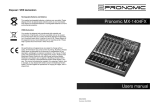



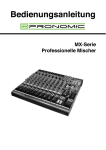




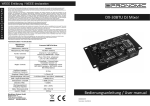


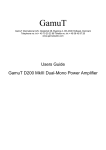

![c]Vai - LPG Wellbox](http://vs1.manualzilla.com/store/data/006783535_1-8f66d58bca4db1da5e064ca69a891161-150x150.png)
